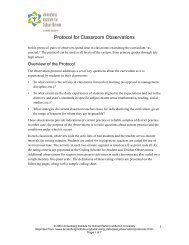Central Falls Transformation Report - Annenberg Institute for School ...
Central Falls Transformation Report - Annenberg Institute for School ...
Central Falls Transformation Report - Annenberg Institute for School ...
You also want an ePaper? Increase the reach of your titles
YUMPU automatically turns print PDFs into web optimized ePapers that Google loves.
Common Planning Time<br />
The primary mechanism <strong>for</strong> staff to collaborate with others was during common planning<br />
time. All teachers met with their house or academy team <strong>for</strong> one period every day. This<br />
space was created so instructional staff could plan interventions <strong>for</strong> specific students,<br />
receive feedback and assistance from colleagues when developing lesson plans, and potentially<br />
develop interdisciplinary instruction. Several teachers indicated there was a wide<br />
range in ability/willingness to work collaboratively across individual teachers and different<br />
teams. The math department was described as a particularly collaborative unit. Members of<br />
the math department reported that common planning time was valuable to them. Even<br />
teachers who were not a part of the math department recognized that team’s successful use<br />
of common planning time. The self-contained special education team also described themselves<br />
as a group who worked well together.<br />
For other teams, the use of common planning time varied. Some teams reported difficulty<br />
collaborating, and members described meetings that were unproductive complaint sessions<br />
or unstructured, free-<strong>for</strong>m discussions that varied in utility from week to week. As previously<br />
noted above, classroom coverage due to teacher absences made it difficult <strong>for</strong> teachers<br />
to participate during regularly scheduled common planning time. One team noted not<br />
having been able to meet as a group “<strong>for</strong> weeks.” Another teacher mentioned that covering<br />
classes was “threatening” common planning time, with a different team member being out<br />
every day in a week. Finally, a few teachers also mentioned the lack of a necessary structure<br />
<strong>for</strong> teachers to collaborate within subject areas, not just across teams.<br />
Behavior Management<br />
Behavior management was frequently cited as a challenge that negatively affected the culture<br />
and climate at CFHS. In interviews and focus groups, especially those conducted in<br />
late 2010, teachers, staff, and students reported a lack of consistent rules regarding behavior<br />
management. In particular, they felt that using “restorative practices” as a behavior<br />
management model was the major contributing factor <strong>for</strong> poor student behavior because<br />
the model lacked firm consequences <strong>for</strong> students. Both staff and students felt that the inschool<br />
support (ISS)/restoration room did not help in deterring behavior incidents. In fact,<br />
students noted how some of their peers “use [ISS] as a way to get out of class. People go in<br />
there and do nothing the whole period.” Students and staff noted, however, that the behavior<br />
issues and classroom disruptions could be attributed to a “small percentage” of students,<br />
specifically lowerclassmen. A leadership team member added, “Inconsistent rules<br />
currently exist within the high school; more grounded policies and procedures need to be<br />
communicated and en<strong>for</strong>ced.”<br />
Changes to Behavior Management Processes<br />
Due to the concerns about student behavior, some mid-year changes were made to the<br />
behavior management process. Four restorative specialists were hired to work with students<br />
outside of the classroom to resolve behavior issues by using open communication and<br />
problem-solving strategies that involve student participation and input. These specialists<br />
39













